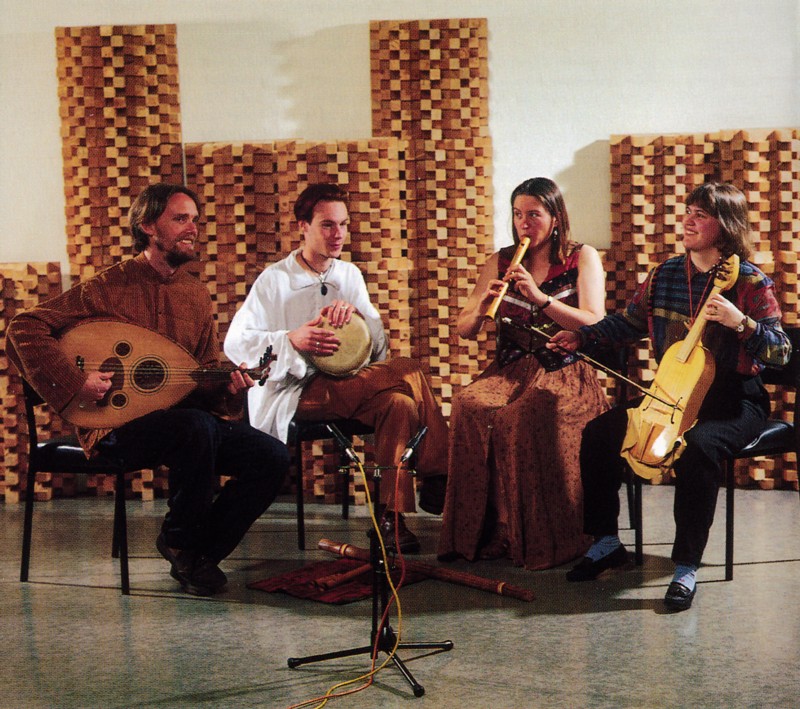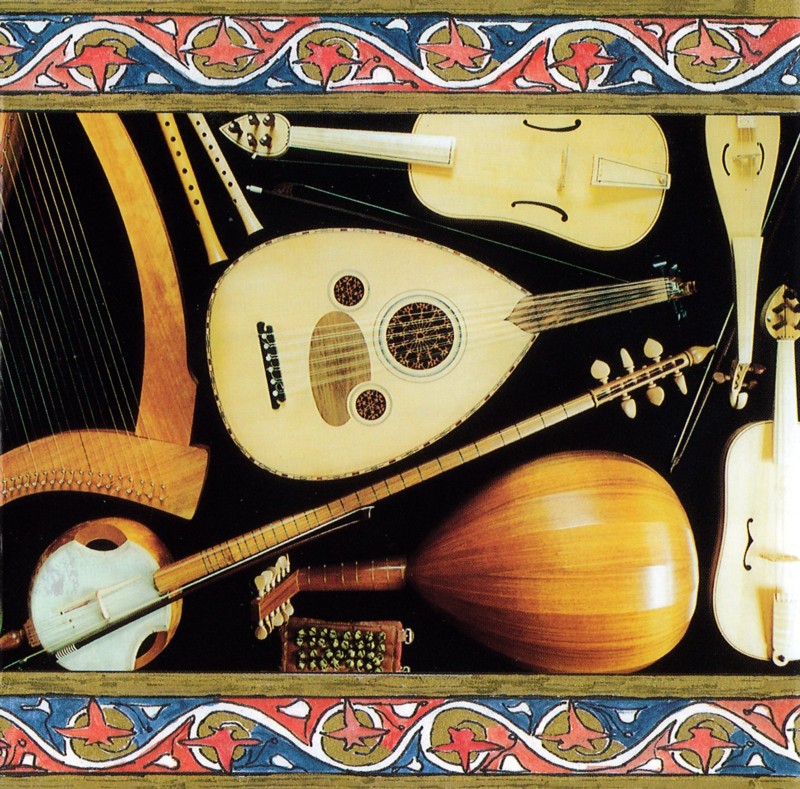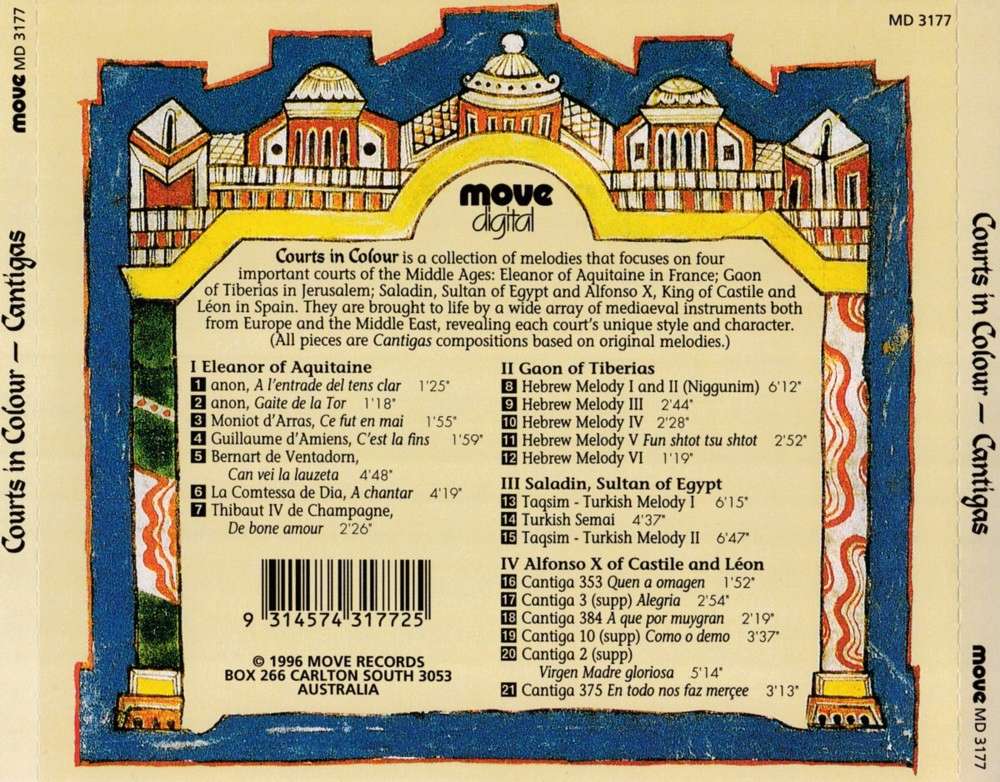Courts in Colour
/ Cantigas

medieval.org
move.com.au
Move MD 3177
1996
cm
I Eleanor of Aquitaine
1. A l'entrade del tens clar [1:25] anon.
ganassi, vielle, 2 darabouka
2. Gaite de la Tor [1:18] anon.
vielle, darabouka
3. Ce fut en mai [1:55]
Moniot d'ARRAS
4. C'est la fins [1:59]
Guillaume d'AMIENS
ganassi, vielle, 2 darabouka
5. Can vei la lauzeta [4:48]
Bernart de VENTADORN
rebec, harp, lute
6. A chantar [4:19]
La COMTESSA de DIA
voice flute, vielle, lute
7. De bone amour [2:26]
THIBAUT IV de Champagne,
hurdy-gurdy, darabouka, bells
II Gaon of Tiberias
8. Hebrew Melody I and II (Niggunim) [6:12]
9. Hebrew Melody III [2:44]
10. Hebrew Melody IV [2:28]
ganassi, vielle, 2 darabouka
11. Hebrew Melody V Fun shtot tsu shtot [2:52]
ganassi, vielle, darabouka, bells
12. Hebrew Melody VI [1:19]
ganassi, darabouka, rainstick
III Saladin, Sultan of Egypt
13. Taqsim — Turkish Melody I [6:15]
yayla-tanbur, darabouka, tambourine
14. Turkish Semai [4:17]
vielle, oud, darabouka
15. Taqsim — Turkish Melody II [6:47]
oud, darabouka
IV Alfonso X of Castile and León
16. Cantiga 353 Quen a omagen [1:52]
CSM 353
vielle, lute, yayla-tanbur, darabouka
17. Cantiga 3 (supp) Alegria [2:54]
CSM 425
vielle, lute, yayla-tanbur, darabouka
18. Cantiga 384 A que por muy gran [2:19]
CSM 384
vielle, lute, yayla-tanbur, darabouka
19. Cantiga 10 (supp) Como o demo [3:37]
CSM 407
voice flute, harp, darabouka
20. Cantiga 2 (supp) Virgen Madre gloriosa [5:14]
CSM 412
voice flute, rebec, oud, darabouka
21. Cantiga 375 En todo nos faz merçee [3:13]
CSM 375
vielle, lute, yayla-tanbur, darabouka
All pieces are Cantigas compositions based on original melodies

Cantigas
Zona Clarke: ganassi recorder, voice flute, rebec, yayla-tanbur
Caroline Downer: vielle, harp, hurdy-gurdy
Philip Gunter: oud, lute, darabouka, bells
with
Simon Gorman: darabouka, bells, rainstick
Cantigas
plays a repertoire of mediaeval and folk-based music from Europe, Asia
and the Middle East. The group explores instrumental sounds and timbres
using hand-crafted Australian reproductions of period instruments. The
group generally plays in mean-tone temperament and at the pitch A466 as
it is believed that pitch was higher in the Middle Ages. The music is
all monophonic, that is single line melodies and in most cases merely
fragments.
Cantigas thus recreates the music of the Middle Ages
with authentic compositions which use techniques of mediaeval
performance practice such as counter-melodies, drones, rhythm parts and
much creative improvisation.
The Recording
Courts in Colour was recorded in Move studios at Eaglemont in digital stereo and in single takes with no mixing.
Cantigas aims to produce a sound that is true to a spontaneous performance with live improvisation.
Acknowledgments: Kaz Ross
Programme notes: C. Downer and Z. Clarke
Instrument photograph: C. Cooper
Group photograph: Howard Bimstihl
Borders: C. Downer
Recording engineers: Martin Wright and Vaughan McAlley
© 1996 MOVE RECORDS

Eleanor of Aquitaine (1122-1204) was a highly
influential patron of the Arts and a key political figure.
Twelfth-century France was a place of relative peace and a renaissance
in artistic and intellectual pursuits. Her court at Aquitaine was a
melting pot for various folkloric and narrative traditions; it was here
that the troubadour arts flourished, influenced by the ideal of
aristocratic courtly love. The troubadours themselves came from all
walks of life; from kings (Richard I of England) to servants (Bernart de
Ventadorn). They were, however, a class of well-educated men, the
majority of which were minor nobility, mainly landless second sons. The
historical evidence for the lives of the troubadours are a series of
biographies called Vidas and commentaries, Razos,
although these are not entirely reliable as they tend to be derived from
the poems themselves. The troubadour movement encouraged the rise of
secular song, influencing the trouvères in northern France and the
Minnesingers in Germany. Cantigas uses the differing timbres of mediaeval European instruments including the hurdy-gurdy, lute, vielle, rebec, and harp.
The
greater part of the Jewish population in the Middle Ages lived in the
Muslim world in such countries as Palestine, Persia, Syria, Egypt, North
Africa and Spain. There were four central authorities which governed
over the body of customs and laws encompassing every aspect of Jewish
life from ritual to routine. One of these authorities was the
Palestinian Academy in Jerusalem whose head was entitled the 'Gaon of Tiberias'
(1000-1077). This academy claimed a particular standing in the Jewish
nation directly related to the importance of the Holy Land and the Holy
City. It was not only a place of study but also an important element in
the structure of Jewish autonomy recognised by the Muslim authorities.
The head of the Academy was the officially recognised representative of
Palestinian Jewry in its dealings with the local government in the
capital Ramle. The Academy is expressed through rhythmic Hebrew
melodies, reflecting the festive dancing of the Jewish people with
exotic sounds of the recorder and the Arabic drum, the darabouka.
Saladin, Sultan of Egypt
(1145-1234), was the archrival of Richard the Lionheart and succeeded
in bringing the Muslim factions together to fight against the Europeans
in the Third Crusade. His empire included Egypt as well as Syria and
parts of Turkey. He was a devout Muslim and was thought of very highly
by his contemporaries, both friends and enemies. The intimate quality of
this art-music is expressed by taqsims, that is, long improvised
introductions exploring the maqams or scales of the piece and
by using ethnic Arabic instruments such as the oud, yayla-tanbur and
darabouka. The music is characterised by the additive rhythms such as
10/8 and 7/8 and the melodic subtleties of quarter-tones and Middle
Eastern tuning systems.
Alfonso X, 'the wise',
King of Castile and Léon (1252-1284) was a very important patron of the
Arts in the Middle Ages. He deliberately promoted the rise of the
vernacular, using Castilian as the language of law, history and official
records. The translation of scientific and philosophical works from
Arabic flourished in his court. Alfonso's tastes were wide-ranging; he
wrote books on chess, astronomy and history. The music of this court is
all taken from the lavishly illustrated manuscript Cantigas de Santa Maria.
This collection of four hundred songs was assembled at the court of
Alfonso and recounts miracles of the Virgin Mary. The simple melodies
are influenced by the troubadours; many fled south to Northern Italy,
Sicily and Spain to escape the Albigensian Crusade of 1209. Some sought
refuge at the cosmopolitan court of Alfonso X which became a place for
the gathering together of intellectuals; Arabs, Jews and Christians.
This is portrayed by the use of instruments from the East and the West
and is linked by a subtle yet lively string sound.




